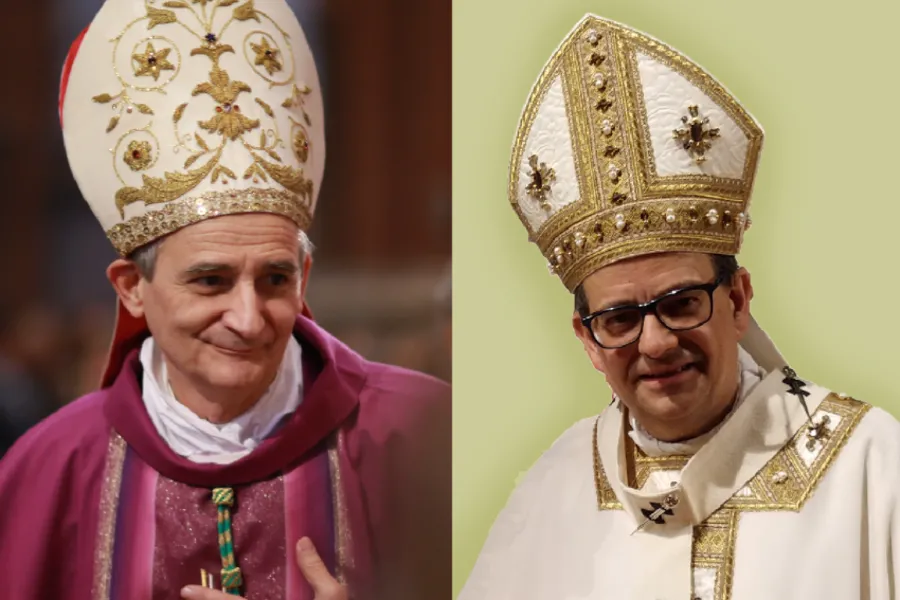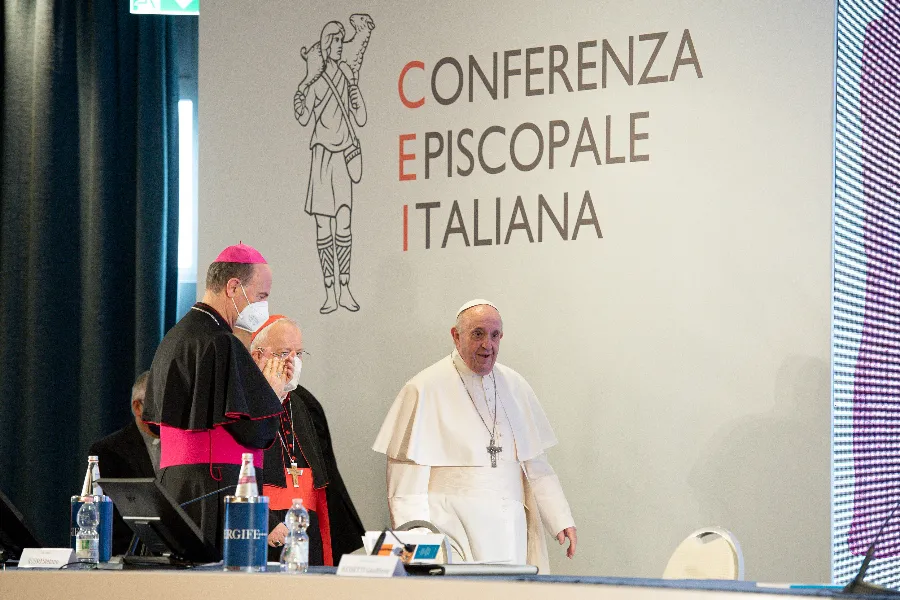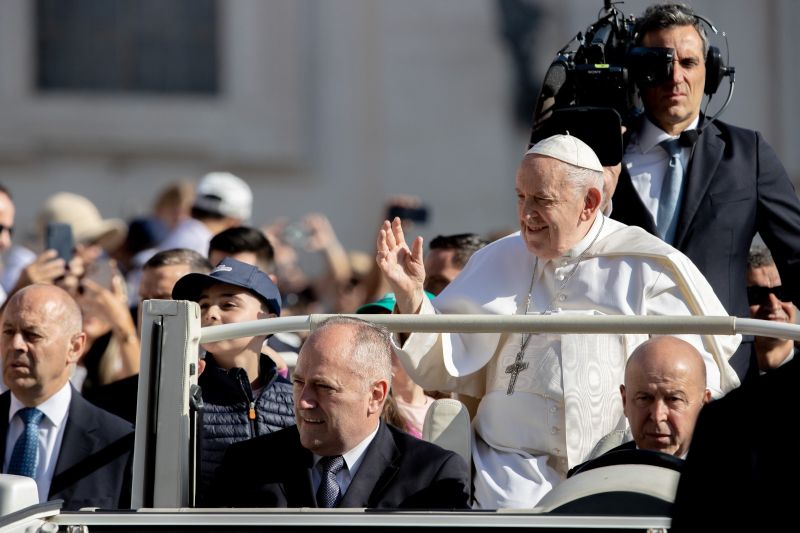
Rome Newsroom, Jan 15, 2023 / 11:00 am (CNA).
It was widely anticipated that a major reform of the Diocese of Rome was coming, as Pope Francis has been thinking about it for some time.
But no one expected it to come when it did: On Jan. 6, one day after the funeral of Francis’ predecessor as Bishop of Rome, Pope Emeritus Benedict XVI.
With the reform, Pope Francis firmly took over the reins of the vicariate, or hierarchy, of the diocese. Everything is centralized, and everything must pass, at least formally, under the control of the pontiff.
Cardinal Angelo de Donatis, the pope’s vicar for the diocese, sees his role deeply diminished. The diocese’s auxiliary bishops strengthen their direct link with the pope. In the end, the pope has made it clear that he is the one who also formally presides over the Episcopal Council, a new body established as an “expression of synodality.”

The backstory
Before going into some details of the new decree, however, some background is necessary.
The last reform of the structure of the Vicariate of Rome was outlined by John Paul II in 1998, with the apostolic constitution Ecclesia In Urbe. For the new reform, Pope Francis copied and pasted several passages from that document. In some cases, these have been minimally rewritten to emphasize some details instead of others. In other cases, greater changes were made but these do little to alter the basic substance of things.
The reform presents two general characteristics of Pope Francis’ way of legislating: using councils or commissions and requiring those bodies to report directly to him.
It is clear that the pope is the bishop of Rome and that the pope’s vicar for the diocese is his auxiliary. Pope Francis, however, in this case, goes further, including with the constitution a decree that directly defines the areas of competence of the auxiliary bishops.
Pope Francis shows, in this way, a willingness to exercise greater personal control over everything that happens in the vicariate. At the same time, this choice also testifies to a “break” in the relationship of trust with his vicar, Cardinal de Donatsi.
Although Francis called de Donatis to preach retreats to the Roman Curia in 2014, he was never the pope’s candidate to succeed Cardinal Vallini as vicar. That was Cardinal Paolo Lojudice.
Pope Francis, however, wanted to first consult the parish priests of Rome, 80% of whom preferred de Donatis. It was impossible, therefore, for the pope not to listen to them. He appointed De Donatis vicar (and cardinal) and made Lojudice archbishop of the prestigious Diocese of Siena, and a cardinal, as well.
Last May, at the general assembly of the Italian Episcopal Conference, it seemed clear that Pope Francis preferred the appointment of Cardinal Lojudice as the new president of the CEI.

The plan was to appoint Lojudice vicar of the Diocese of Rome to succeed Cardinal de Donatis, who had finished his five-year term, which would then have made Lojudice the primary contact person for the pope both in Rome and among the Italian bishops. De Donatis would have been appointed the new Penitentiary in place of Cardinal Mauro Piacenza, who has now turned 78.
The Italian bishops, however, preferred Cardinal Matteo Zuppi, archbishop of Bologna, who was not unwelcome to Pope Francis.
Lojudice didn’t become vicar for the Rome Diocese, either, as everyone assumed would happen. Meanwhile, the relationship of trust between de Donatis and the pope seemed to have been interrupted in 2020, when, at the beginning of the lockdown for COVID-19, de Donatis decided to close the churches of Rome. When Pope Francis later highlighted the inadvisability of closing churches, de Donatis withdrew the decree but announced that every decision had been made in agreement with the pope. There also have been other moments of friction in recent years.
The pope, however, now seems intent on changing the vicar this year when de Donatis’ mandate expires. An indication of this is the fact that in the decree in which the Pope defines the area and pastoral competencies of the auxiliary bishops, de Donatis is not mentioned as vicar. One might take his presence for granted, of course, but the general interpretation is that the change will be made.
What’s new
What are the novelties introduced by Pope Francis? First, the figure of the prelate general secretary disappears, while the vicegerente (or the deputy of the vicar) manages the offices of the General Secretariat. The prelate secretary also had the function of the moderator of the Curia. In this case, everything is entrusted to the vicegerente, who thus sees his functions and weight increase.
The pope chose the vicegerente from among the auxiliary bishops, and in this case, Baldassare Reina was selected. Bishop Reina does not come from the Diocese of Rome but was called from Agrigento. The pope’s logic is to break possible power chains by bringing in fresh and foreign forces.
The choice of a new parish priest is entrusted to a lengthy procedure which must then, in any case, be submitted to the pope, who acts as the true and proper bishop of Rome without relying on the vicar, who is left with the appointment of assistant parish priests.
Article 20 of the Constitution requests a report for each candidate for the priesthood or diaconate to be submitted before ordination. Also, in this case, the candidates must be presented by the cardinal vicar to the pope, and only after obtaining the Episcopal Council’s consent. Therefore, the vicar seems to be practically a commissariat: He does not choose the candidates but submits them to the pope and can submit them only after the Episcopal Council has endorsed the choice.
The council is defined as the “first organ of Synodality” and must meet “at least three times a month,” presided over by the pope. Only in the absence of the pope can the cardinal vicar preside over the council, which is made up of the vicegerent and the auxiliary bishops. However, the pope wants to receive “the agenda for each meeting as soon as possible.”
Finally, there is also the establishment of an Independent Supervisory Commission. This will have a regulation that must be “approved by the Pope” and six members appointed by the pope who can remain in office for a maximum of two five-year terms.
The service for the protection of minors and vulnerable people is also added, which “reports to the Episcopal Council, through the auxiliary bishop appointed by me,” the pope has decreed.

The effects of the reform
The constitution also redistributes the areas and offices of the Vicariate’s Curia, and the accompanying decree gives each auxiliary bishop a specific task.
Beyond the reorganization, it should be noted how the pope enters into action as the actual bishop of Rome. Everything must pass through the decisions of the pope, while before, the cardinal vicar enjoyed trust and discretion. For the first time, however, the pope’s vicar is defined as an “auxiliary.” He is, therefore, an auxiliary among the auxiliaries, with a considerable reduction in his weight.
With this centralization, Pope Francis probably wants to overcome the risk of having “abuses” within the Vicariate.
It is worth remembering that in June 2021, Pope Francis ordered an inspection of the Vicariate itself. It was an audit entrusted to the Auditor General of the Holy See, Alessandro Cassinis Righini. It was the first time the Vicariate sifted through the accounting books, registers, and cooperative societies.
However, the Pope, as a matter of practice, has sent an inspection to all the dicasteries of the Curia every time there is a reform or a new mandate. The review, therefore, already predicted the change of pace in the Vicariate, one that has led Pope Francis to be increasingly alone in command.
If you value the news and views Catholic World Report provides, please consider donating to support our efforts. Your contribution will help us continue to make CWR available to all readers worldwide for free, without a subscription. Thank you for your generosity!
Click here for more information on donating to CWR. Click here to sign up for our newsletter.







Not qualified to have an attitude about the Bishop of Rome’s reorganization within his Diocese of Rome–but left with three hypothetical and possibly larger questions:
First, if the combined Episcopal Council replaces the auxiliary bishops, personally and individually, then is this reorganization a statement about either (a) the shared responsibilities of some bishops worldwide with their archbishops (possibly a step toward real synods, ecumenically comparable with Eastern Patriarchates?), or (b) the subordination of all individual bishops toward their lesser and only collective national conferences of bishops?
Second, does the administrative reorganization within the Diocese of Rome also and ambiguously affect, then, the robust doctrinal responsibilities of each bishop—individually and personally vis a vis the Papacy—as a Successor of the Apostles?
Third, within the Church as an ecclesial unity, would such a decentralized model of “hierarchical communion” still conform to Lumen Gentium (Chapter 3, and especially the Explanatory Note)? Or not (a discontinuous paradigm-shift)?
Getting back to the precipitating incident, in itself, was Pope Francis’ opposition to the closing of churches in his diocese such a bad idea? But, now this, hypothetically?
Under the “Backstory” heading, second paragraph, “1908” should be “1998.”
Thank you! It has been corrected.
Di Donatis, “Grandmother dear, what big teeth you have!”. His Holiness, “The better to eat you with!”.
As bishop of Rome, it would appear logical that the pontiff assume absolute authority. Simply for sake of effective management. However, he’s also the Vicar of Christ for the universal Church. A far greater managerial responsibility, whereas delegation for Rome is more reasonable than not.
His legacy to date has been an absorption of authority from areas in which decisions and policy were delegated. For example the Card DiNardo attempt to address adult clerical homosexual relations quashed, DiNardo humiliated, CDF prefect Card Müller’s staff dismissed without giving reason, when asked, “I’m the pope. I don’t need to answer questions!”.
A test case for analysis is the question of direction. The Church. There is no greater mechanism for change of direction from a predominantly doctrinal oriented Catholicism to pastoral than the Synod on Synodality. Here the anomaly [or is it anomaly?] is His Holiness’ withdrawal from exercise of his supreme pontificate allowing matters to run their course according to the [plan] enlightenment of listening to the Holy Spirit wayfarers. As for the Apostolic witnesses to Christ and revelation, the bishops, why behold! They are reduced to note takers. Secretaries.
Ah, the power of those teeth.
“The only garment required for receiving the Eucharist is faith” (Pope Francis). Francis seeks to recreate a perceived, doctrinally confined Church into a more expansive [inclusive] pastoral Church. That should be clear to the reader, the Synod on Synodality the instrument to that effect change, not by formal change of doctrine, rather by legitimizing practice. Supported by interpretation of the Gospels in context of Amoris Laetitia.
Recently, as a supportive proposition for change Pope Francis said he never refused anyone communion. The appeal is to sentiment. And to the reality of a priest’s posture when distributing communion. Many of us can make the same claim. Although, putatively from a somewhat different perspective. It’s not possible to determine what are the interior dispositions of parishioners, whether there is repentance either formally realized or by intent. Similarly, interrogation at communion causes scandal, confusion. A presbyter should inquire when required either prior or after.
It’s an entirely different matter when a known individual who openly promotes, favors abortion approaches. That’s when the issue of ‘garment’ cannot be taken as simplistically proposed by His Holiness. We all know, ‘Even the demons believe’. We know that Christ calls us to repentance.
Repentance and justification have likeness. Luther held that ultimately faith justifies, works do not. Saint Paul held similar in Galatians and Romans. Except that he makes it a point to speak of faith as a disposition to do the will of God, which includes works. That requires repentance for sins and metanoia. Works of charity and compassion. Francis leans toward Luther’s narrowed conception of faith alone.
There are exceptions, and Amoris argues that the presbyter priest or bishop priest must take into account mitigating factors and inviolability of conscience. Fr Thomas Weinandy OFM Cap a credentialed theologian admits there are exceptions when it’s understood that persons are caught in a dilemma of worthiness to receive communion lacking the documentation to receive a declaration of nullity from a tribunal. Priests have through the centuries acknowledged this, Pope Francis’ while initially proposing limited exceptions be more readily considered, has since, in implementation of Amoris Laetitia, his new paradigm widened that initial premise to a virtual universal admonition. Priests are pressured to give the benefit of the doubt to the manifest, unrepentant penitent, whose justification is the garment of faith. Our Church, bishops, presbyters, deacons, religious, laity are challenged in this to address whether by following Pope Francis’ garment of faith proposal we adhere to Christ’s revelation, his commandments to repent. An honest faith inspired response to this proposal is no. Francis’ proposal does not adhere to what Christ commanded us. To love as He has loved us.
1. Consolidate power
2. Hand it over to you-know-who.